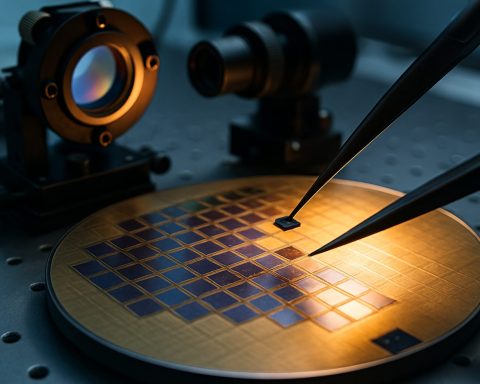Biotextile Engineering in 2025: How Advanced Fibers and Smart Textiles Are Transforming Medical Devices and Patient Care. Explore the Breakthroughs, Market Growth, and Future Outlook of This Rapidly Evolving Sector.
- Executive Summary: Key Trends and Market Drivers in Biotextile Engineering
- Market Size and Growth Forecast (2025–2030): CAGR, Revenue, and Regional Analysis
- Innovative Biotextile Materials: From Bioactive Fibers to Smart Polymers
- Cutting-Edge Applications: Implants, Wound Care, and Wearable Medical Devices
- Regulatory Landscape and Standards: Navigating Compliance in Biotextiles
- Leading Companies and Industry Initiatives (e.g., gore.com, medtronic.com, bionitio.com)
- R&D and Academic Collaborations: Pioneering Research and Breakthroughs
- Sustainability and Biodegradability: Green Solutions in Biotextile Manufacturing
- Challenges and Barriers: Scalability, Biocompatibility, and Market Adoption
- Future Outlook: Emerging Technologies, Investment Hotspots, and Strategic Opportunities
- Sources & References
Executive Summary: Key Trends and Market Drivers in Biotextile Engineering
Biotextile engineering, the convergence of textile science and biotechnology, is rapidly transforming the landscape of medical devices, advanced wound care, and sustainable materials. As of 2025, the sector is witnessing accelerated innovation driven by the demand for biocompatible, functional, and eco-friendly textile solutions. Key trends include the integration of bio-based polymers, the development of smart and responsive fabrics, and the scaling of regenerative medical textiles.
A major driver is the increasing adoption of bioresorbable and biocompatible fibers in implantable medical devices. Companies such as W. L. Gore & Associates and Getinge are at the forefront, supplying vascular grafts, surgical meshes, and sutures made from advanced polymers like expanded polytetrafluoroethylene (ePTFE) and polyglycolic acid (PGA). These materials are engineered for optimal integration with human tissue, reducing complications and improving patient outcomes.
Sustainability is another critical trend, with manufacturers investing in bio-based and biodegradable fibers to address environmental concerns. DuPont continues to expand its portfolio of bio-derived fibers, such as Sorona®, which is partially made from renewable plant-based ingredients. Similarly, Evonik Industries is advancing the use of polyamide 12 (PA12) and other specialty polymers for medical and technical textiles, emphasizing recyclability and reduced carbon footprint.
Smart biotextiles—fabrics embedded with sensors, drug delivery systems, or responsive coatings—are gaining traction in both clinical and consumer health applications. Medtronic and Baxter International are exploring textile-based platforms for continuous monitoring and targeted therapy, leveraging advances in microelectronics and nanofiber engineering.
Looking ahead, the biotextile engineering market is expected to benefit from regulatory support for innovative medical devices, increased investment in R&D, and the growing prevalence of chronic diseases requiring advanced wound care and tissue regeneration. The next few years will likely see further collaboration between material science leaders, medical device manufacturers, and biotechnology firms to accelerate the commercialization of next-generation biotextiles.
- Rising demand for implantable and regenerative textiles in healthcare.
- Expansion of sustainable, bio-based fiber production.
- Emergence of smart, sensor-integrated biotextiles for diagnostics and therapy.
- Strategic partnerships and cross-sector innovation driving market growth.
Market Size and Growth Forecast (2025–2030): CAGR, Revenue, and Regional Analysis
Biotextile engineering, the intersection of biotechnology and textile science, is poised for robust growth between 2025 and 2030, driven by increasing demand for sustainable materials, medical textiles, and advanced functional fabrics. The global biotextile market is expected to experience a compound annual growth rate (CAGR) in the range of 7% to 10% during this period, with revenue projections surpassing USD 6 billion by 2030. This growth is underpinned by rapid advancements in biomaterials, heightened regulatory focus on eco-friendly solutions, and expanding applications in healthcare, sportswear, and technical textiles.
Regionally, North America and Europe are anticipated to maintain leading positions in biotextile innovation and adoption, owing to strong R&D ecosystems, established medical device industries, and supportive regulatory frameworks. The United States, in particular, is home to several pioneering companies such as W. L. Gore & Associates, renowned for its expanded polytetrafluoroethylene (ePTFE) biomaterials used in vascular grafts and surgical meshes. Similarly, Medtronic continues to expand its biotextile-based medical devices portfolio, targeting cardiovascular and soft tissue repair markets.
Europe’s growth is bolstered by the presence of key players like Getinge, which manufactures implantable textile solutions for cardiovascular and general surgery applications. The region’s stringent environmental regulations and circular economy initiatives are also accelerating the shift toward bio-based and biodegradable fibers in both medical and consumer sectors.
Asia-Pacific is projected to be the fastest-growing region, with countries such as China, Japan, and India investing heavily in biotextile R&D and manufacturing capacity. The expansion of the healthcare sector, rising awareness of sustainable materials, and government incentives for green technologies are catalyzing market growth. Companies like Toray Industries are at the forefront, developing advanced bio-based fibers and medical textiles for global markets.
Looking ahead, the biotextile engineering market is expected to benefit from ongoing innovations in biofabrication, such as 3D bioprinting and recombinant protein fibers, as well as the integration of smart functionalities (e.g., drug delivery, biosensing). Strategic collaborations between material science companies, medical device manufacturers, and research institutions will further accelerate commercialization and adoption. As sustainability and performance requirements intensify across industries, biotextile engineering is set to play a pivotal role in shaping the future of both healthcare and advanced textiles worldwide.
Innovative Biotextile Materials: From Bioactive Fibers to Smart Polymers
Biotextile engineering is rapidly evolving in 2025, driven by the convergence of biotechnology, materials science, and textile manufacturing. The sector is witnessing a surge in the development and commercialization of innovative materials, including bioactive fibers, smart polymers, and sustainable biopolymers, with applications spanning healthcare, sportswear, and environmental remediation.
A key trend is the integration of bioactive agents into textile fibers, enabling functionalities such as antimicrobial activity, controlled drug release, and tissue regeneration. Companies like Smith & Nephew are advancing wound care dressings that incorporate bioactive fibers to promote healing and prevent infection. Similarly, ConvaTec is developing biotextile-based medical devices, including advanced wound dressings and ostomy care products, leveraging bioengineered fibers for enhanced patient outcomes.
Smart polymers are another area of rapid innovation. These materials can respond to environmental stimuli—such as temperature, pH, or moisture—making them ideal for next-generation wearable devices and responsive medical textiles. W. L. Gore & Associates, renowned for its GORE-TEX® technology, is expanding its portfolio to include smart biotextiles with adaptive breathability and moisture management for both medical and performance apparel markets.
Sustainability remains a central focus, with biotextile engineering increasingly prioritizing renewable feedstocks and biodegradable materials. DuPont continues to scale up production of Sorona®, a partially bio-based polymer used in textiles that offers both performance and reduced environmental impact. Meanwhile, Novamont is commercializing Mater-Bi®, a family of biodegradable and compostable biopolymers, for use in nonwoven fabrics and hygiene products.
Looking ahead, the outlook for biotextile engineering is robust. The global push for sustainable and functional textiles is expected to accelerate R&D and market adoption. Industry collaborations with academic institutions and healthcare providers are fostering the translation of laboratory innovations into scalable products. Regulatory agencies are also updating standards to accommodate the unique properties of biotextiles, further supporting commercialization.
- Bioactive fibers are being integrated into wound care and implantable devices for improved healing and infection control.
- Smart polymers are enabling responsive textiles for medical, sports, and environmental applications.
- Biodegradable and bio-based polymers are gaining traction as sustainable alternatives to conventional synthetics.
By 2025 and beyond, biotextile engineering is poised to deliver transformative solutions across multiple sectors, with leading companies and research-driven startups shaping the future of functional and sustainable textiles.
Cutting-Edge Applications: Implants, Wound Care, and Wearable Medical Devices
Biotextile engineering is rapidly transforming the landscape of medical devices, with 2025 marking a pivotal year for the integration of advanced textile technologies into implants, wound care, and wearable medical devices. The convergence of biomaterials science, textile manufacturing, and digital health is enabling the creation of next-generation products that are more biocompatible, functional, and patient-centric.
In the field of implants, biotextiles are being engineered for use in vascular grafts, hernia meshes, and soft tissue repair. Companies such as Getinge and Terumo Corporation are at the forefront, developing textile-based vascular grafts that offer improved flexibility, porosity, and integration with host tissue. These products are increasingly incorporating bioresorbable fibers and surface modifications to enhance healing and reduce complications. The trend toward patient-specific, 3D-knitted implants is expected to accelerate, leveraging digital design and advanced manufacturing to tailor solutions for individual anatomical needs.
In wound care, biotextile engineering is enabling the development of advanced dressings and scaffolds that promote faster healing and reduce infection risk. Smith+Nephew and ConvaTec are leading suppliers of textile-based wound dressings that incorporate antimicrobial agents, moisture management, and bioactive components. Recent innovations include electrospun nanofiber mats and hydrogel-impregnated fabrics, which provide optimal environments for cell proliferation and tissue regeneration. The integration of sensors into wound dressings for real-time monitoring of healing parameters is anticipated to become more prevalent in the next few years.
The sector of wearable medical devices is witnessing a surge in biotextile-based solutions that combine comfort, durability, and advanced sensing capabilities. Medtronic and Philips are investing in textile-integrated biosensors for continuous monitoring of vital signs, glucose levels, and other physiological parameters. These smart textiles are designed to be washable, stretchable, and unobtrusive, supporting long-term patient adherence. The next few years are expected to see the commercialization of fully integrated textile systems capable of both monitoring and delivering therapies, such as drug release or electrical stimulation, in response to real-time data.
Looking ahead, the outlook for biotextile engineering in these applications is robust. Regulatory pathways are becoming clearer, and collaborations between textile manufacturers, medtech firms, and research institutions are intensifying. As material science advances and digital health technologies mature, biotextile-based implants, wound care products, and wearables are poised to become standard components of personalized and connected healthcare by the late 2020s.
Regulatory Landscape and Standards: Navigating Compliance in Biotextiles
The regulatory landscape for biotextile engineering in 2025 is rapidly evolving, reflecting the sector’s growing importance in medical, environmental, and consumer applications. Biotextiles—engineered fabrics derived from natural or bio-based polymers—are subject to a complex web of standards and compliance requirements, particularly as they intersect with healthcare, sustainability, and advanced manufacturing.
In the medical sector, biotextiles used for implants, wound care, and tissue engineering must comply with stringent regulations. The U.S. Food and Drug Administration (FDA) continues to update its guidance for medical devices incorporating textile components, emphasizing biocompatibility, sterility, and traceability. The FDA’s 510(k) and Premarket Approval (PMA) pathways require robust data on material safety and performance, and recent years have seen increased scrutiny of bioresorbable and bioactive textile implants. Similarly, the European Medicines Agency (EMA) and the International Organization for Standardization (ISO) have updated standards such as ISO 10993 for biological evaluation of medical devices, directly impacting biotextile manufacturers.
Sustainability is another regulatory driver. The European Union’s Green Deal and Circular Economy Action Plan are pushing for stricter controls on the sourcing, production, and end-of-life management of biotextiles. The European Chemicals Agency (ECHA) is expanding its REACH regulations to cover more bio-based chemicals and additives, requiring detailed disclosure and risk assessment. In the U.S., the Environmental Protection Agency (EPA) is increasing oversight of bio-based textile processing, particularly regarding water use, effluent quality, and lifecycle impacts.
Industry bodies are also shaping the compliance landscape. The American Association of Textile Chemists and Colorists (AATCC) and the ASTM International are developing new test methods and performance standards for biotextiles, including durability, biodegradability, and antimicrobial efficacy. These standards are increasingly referenced in procurement and certification processes, especially for suppliers to major healthcare and apparel brands.
Looking ahead, the next few years will likely see further harmonization of global standards, with digital traceability and lifecycle assessment becoming mandatory for many biotextile products. Companies such as W. L. Gore & Associates—a leader in medical and performance biotextiles—are investing in compliance infrastructure and collaborating with regulators to shape future requirements. As regulatory expectations rise, proactive engagement with evolving standards will be critical for biotextile innovators seeking market access and competitive advantage.
Leading Companies and Industry Initiatives (e.g., gore.com, medtronic.com, bionitio.com)
Biotextile engineering, a field at the intersection of materials science, biotechnology, and textile manufacturing, is experiencing rapid innovation in 2025. The sector is driven by the demand for advanced medical textiles, sustainable biomaterials, and high-performance fabrics for healthcare and industrial applications. Several leading companies and industry initiatives are shaping the landscape, focusing on both product development and sustainable practices.
A global leader in biotextile engineering is W. L. Gore & Associates, renowned for its GORE-TEX® technology and a broad portfolio of medical devices. In 2025, Gore continues to expand its range of implantable biomaterials, including vascular grafts, surgical meshes, and patch materials, all engineered for biocompatibility and durability. The company’s ongoing research into ePTFE (expanded polytetrafluoroethylene) and other advanced polymers is setting new standards for implant longevity and patient outcomes.
Another major player is Medtronic, which integrates biotextile engineering into its cardiovascular and surgical product lines. Medtronic’s innovations include textile-based heart valve components and stent grafts, leveraging textile structures for flexibility and tissue integration. The company’s focus on minimally invasive solutions is driving the development of next-generation biotextile devices that reduce recovery times and improve procedural success rates.
Emerging companies are also making significant contributions. Bionitio is advancing the use of bioengineered fibers for wound care and tissue scaffolding. Their proprietary processes enable the production of customizable, biodegradable textiles that support cell growth and healing, addressing the growing need for regenerative medicine solutions.
Sustainability is a key industry initiative, with companies like W. L. Gore & Associates and others investing in greener manufacturing processes and bio-based polymers. The adoption of life cycle assessment tools and closed-loop recycling systems is expected to accelerate through 2025 and beyond, as regulatory and consumer pressures mount.
- Collaborative research: Partnerships between industry and academic institutions are intensifying, with joint ventures focused on smart textiles, antimicrobial coatings, and bioresorbable materials.
- Regulatory alignment: Companies are working closely with regulatory bodies to ensure compliance and safety, particularly for implantable and wearable biotextiles.
- Market outlook: The global biotextile market is projected to grow steadily, driven by aging populations, chronic disease prevalence, and the expansion of personalized medicine.
In summary, 2025 marks a period of dynamic growth and innovation in biotextile engineering, with established leaders and agile startups alike pushing the boundaries of what is possible in medical and sustainable textile applications.
R&D and Academic Collaborations: Pioneering Research and Breakthroughs
Biotextile engineering, at the intersection of biotechnology and textile science, is experiencing a surge in R&D and academic collaborations as the sector seeks sustainable, high-performance materials for medical, apparel, and industrial applications. In 2025, leading universities, research institutes, and industry players are intensifying efforts to develop next-generation biotextiles, focusing on bio-based fibers, smart textiles, and regenerative medical fabrics.
A prominent example is the ongoing partnership between DSM—a global science-based company active in health, nutrition, and materials—and academic institutions to advance high-strength, biocompatible fibers for medical implants and sutures. DSM’s Dyneema Purity® fiber, used in cardiovascular and orthopedic devices, is the result of such collaborations, and the company continues to invest in R&D for new biopolymer-based textile solutions.
In the apparel sector, Bolt Threads is collaborating with universities and fashion brands to scale up production of Mylo™, a mycelium-based leather alternative. The company’s partnerships with academic labs have accelerated the optimization of fermentation and processing techniques, aiming for commercial-scale output by 2026. Similarly, Spiber Inc. in Japan is working with research institutions to refine its Brewed Protein™ fibers, derived from microbial fermentation, for use in both performance wear and medical textiles.
Academic consortia are also playing a pivotal role. The Massachusetts Institute of Technology (MIT) and Stanford University are leading multi-institutional projects on programmable biotextiles, integrating biosensors and responsive materials for health monitoring and drug delivery. These initiatives are supported by government grants and industry sponsorships, with pilot projects expected to yield prototype smart fabrics by 2027.
In Europe, Freudenberg Group is collaborating with technical universities to develop biodegradable nonwovens for hygiene and medical applications. Their joint research focuses on optimizing the lifecycle and end-of-life properties of biotextiles, aligning with the EU’s Green Deal objectives.
Looking ahead, the outlook for biotextile engineering R&D is robust. The convergence of synthetic biology, materials science, and digital fabrication is expected to yield breakthroughs in customizable, eco-friendly textiles. With increased funding and cross-sector partnerships, the next few years will likely see the commercialization of advanced biotextiles with applications ranging from regenerative medicine to circular fashion, positioning the field at the forefront of sustainable innovation.
Sustainability and Biodegradability: Green Solutions in Biotextile Manufacturing
Biotextile engineering is rapidly advancing toward sustainability and biodegradability, with 2025 marking a pivotal year for green solutions in manufacturing. The sector is responding to mounting regulatory and consumer pressures to reduce environmental impact, focusing on renewable feedstocks, closed-loop processes, and end-of-life solutions for textile products.
A key trend is the adoption of bio-based polymers and fibers derived from agricultural waste, algae, and bacterial fermentation. Companies such as Novamont are scaling up production of biopolymers like Mater-Bi, which are used in textile applications and are certified compostable. Similarly, NatureWorks LLC continues to expand its Ingeo™ polylactic acid (PLA) fiber portfolio, with new grades designed for enhanced mechanical properties and faster biodegradation in industrial composting environments.
In 2025, the integration of circular economy principles is becoming standard practice among leading biotextile manufacturers. Lenzing AG is a prominent example, producing TENCEL™ lyocell and modal fibers from sustainably sourced wood pulp using a closed-loop process that recycles over 99% of solvents and water. The company has announced further investments in carbon-neutral production and is piloting new fiber blends with increased post-consumer recycled content.
Biodegradability testing and certification are also gaining traction, with organizations like European Bioplastics and TÜV Rheinland providing standards and verification for compostability and environmental safety. These certifications are increasingly required by major apparel brands and retailers as part of their sustainability commitments.
Looking ahead, the outlook for biotextile engineering is shaped by ongoing R&D into next-generation materials. Companies such as Bolt Threads are commercializing mycelium-based leathers and protein-based fibers, aiming for full biodegradability and minimal resource use. Meanwhile, DuPont continues to innovate with Sorona® fibers, partially derived from renewable plant-based feedstocks, and is working to improve their end-of-life compostability.
By 2025 and beyond, the convergence of material science, process engineering, and regulatory frameworks is expected to accelerate the adoption of green solutions in biotextile manufacturing. The sector is poised for significant growth as brands and consumers increasingly prioritize products with verifiable sustainability and biodegradability credentials.
Challenges and Barriers: Scalability, Biocompatibility, and Market Adoption
Biotextile engineering, which merges textile science with biotechnology to create advanced materials for medical, environmental, and consumer applications, is poised for significant growth in 2025 and the coming years. However, the sector faces persistent challenges related to scalability, biocompatibility, and market adoption that must be addressed to realize its full potential.
Scalability remains a primary barrier. While laboratory-scale production of biotextiles—such as bacterial cellulose fibers, protein-based yarns, and bioengineered silk—has demonstrated promising results, transitioning to industrial-scale manufacturing is complex. Companies like Bolt Threads and Spiber Inc. have made notable progress in scaling up biofabricated fibers, but both have encountered delays and technical hurdles in achieving consistent, high-volume output. The fermentation processes required for microbial or protein-based fibers are sensitive to contamination and require precise control, which increases operational costs and limits throughput. In 2024, Spiber Inc. announced the expansion of its production facilities in the U.S. and Thailand, yet acknowledged that reaching cost parity with conventional textiles remains a multi-year challenge.
Biocompatibility is critical, especially for medical biotextiles used in implants, wound dressings, and tissue engineering scaffolds. Ensuring that materials do not provoke immune responses or degrade unpredictably in the body is a significant scientific and regulatory hurdle. Companies such as W. L. Gore & Associates and Baxter International Inc. are leaders in developing biocompatible textile implants, but the path from prototype to clinical use is lengthy due to stringent testing and approval processes. In 2025, ongoing collaborations between biotextile startups and established medical device firms are expected to accelerate the validation of new materials, but regulatory timelines will continue to slow widespread adoption.
Market adoption is influenced by both cost and consumer perception. Biotextiles often command a premium price due to their novel production methods and sustainability claims. However, mainstream brands and manufacturers are cautious about integrating these materials until they demonstrate reliability, scalability, and clear environmental benefits. Adidas AG and Stella McCartney Ltd. have piloted products using biotextiles, but large-scale rollouts are contingent on supply chain stability and consumer demand. In 2025 and beyond, increased transparency, third-party certifications, and successful high-profile product launches are expected to drive broader acceptance, though market penetration will likely remain gradual.
In summary, while biotextile engineering is advancing rapidly, overcoming the intertwined challenges of scalability, biocompatibility, and market adoption will require sustained investment, cross-sector collaboration, and continued technological innovation over the next several years.
Future Outlook: Emerging Technologies, Investment Hotspots, and Strategic Opportunities
Biotextile engineering is poised for significant transformation in 2025 and the coming years, driven by rapid advances in biomaterials, sustainable manufacturing, and medical applications. The sector is witnessing a surge in R&D investment, with a focus on next-generation fibers derived from renewable sources, such as bacterial cellulose, mycelium, and recombinant proteins. These innovations are not only reducing environmental impact but also enabling new functionalities in medical, technical, and performance textiles.
One of the most prominent developments is the scaling of microbial and plant-based textile production. Companies like Bolt Threads are commercializing mycelium-based leather alternatives and spider silk-inspired fibers, targeting both fashion and biomedical markets. Similarly, Modern Meadow is advancing protein-based materials for use in both apparel and medical devices, leveraging biofabrication to create customizable, high-performance textiles.
In the medical sector, biotextiles are increasingly integral to tissue engineering, wound care, and implantable devices. Firms such as Integra LifeSciences are expanding their portfolios of collagen-based scaffolds and regenerative matrices, which are critical for soft tissue repair and reconstruction. The convergence of 3D bioprinting and textile engineering is also opening new avenues for patient-specific implants and drug delivery systems, with ongoing collaborations between industry and academic research centers.
Sustainability remains a central investment hotspot. Major apparel and textile manufacturers, including Adidas and Patagonia, are partnering with biotextile innovators to integrate bio-based fibers and reduce reliance on petrochemical-derived synthetics. These partnerships are expected to accelerate the commercialization of biodegradable and circular textile solutions, responding to regulatory pressures and consumer demand for eco-friendly products.
Strategically, the next few years will see increased cross-sector collaboration, with biotextile engineering intersecting with synthetic biology, advanced manufacturing, and digital design. Investment is flowing into pilot-scale facilities and supply chain integration, particularly in North America, Europe, and parts of Asia. The outlook for 2025 and beyond suggests that companies able to combine material innovation with scalable, sustainable production will capture significant market share, especially as regulatory frameworks tighten around environmental impact and product safety.
- Key emerging technologies: microbial fermentation, 3D bioprinting, recombinant protein spinning, and mycelium cultivation.
- Investment hotspots: sustainable fashion, medical biotextiles, and circular textile supply chains.
- Strategic opportunities: partnerships between biotech startups and established textile/apparel brands, and integration of digital manufacturing tools.
Sources & References
- W. L. Gore & Associates
- Getinge
- DuPont
- Evonik Industries
- Medtronic
- Baxter International
- Smith & Nephew
- ConvaTec
- Novamont
- Terumo Corporation
- Philips
- European Medicines Agency
- International Organization for Standardization
- European Chemicals Agency
- American Association of Textile Chemists and Colorists
- ASTM International
- DSM
- Bolt Threads
- Spiber Inc.
- Massachusetts Institute of Technology
- Stanford University
- Freudenberg Group
- NatureWorks LLC
- Lenzing AG
- European Bioplastics
- TÜV Rheinland
- Bolt Threads
- Spiber Inc.
- W. L. Gore & Associates
- Baxter International Inc.
- Modern Meadow
- Patagonia







